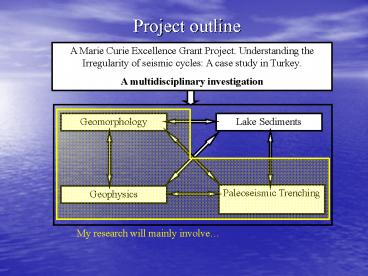Project outline - PowerPoint PPT Presentation
1 / 9
Title:
Project outline
Description:
To further constrain the timing, extent and nature of ground rupturing ... Aegean Sea. Karliova Junction. 1. 2. 3. 4. Various Faulting with in the 'Anatolian ova' ... – PowerPoint PPT presentation
Number of Views:82
Avg rating:3.0/5.0
Title: Project outline
1
Project outline
A Marie Curie Excellence Grant Project.
Understanding the Irregularity of seismic cycles
A case study in Turkey. A multidisciplinary
investigation
Geomorphology
Lake Sediments
Paleoseismic Trenching
Geophysics
My research will mainly involve
2
- Primary objective
- To further constrain the timing, extent and
nature of ground rupturing earthquakes on the
North East Anatolian Faults using
geomorphology, geophysics and trenching while
working in conjunction with lake sediment coring
and analysis to increase the understanding of
the nature of seismic cycles on the North East
Anatolian Faults. - Secondary objective
- To evaluate several methods of measuring the
distribution of the physical properties of
materials in paleoseismic trenches with the aim
of uncovering further stratigraphy therefore
potentially providing more detailed constraint on
paleoearthquake timing.
3
Process of investigation
This iterative style of investigation is required
due to annual weather variation but allows the
investigation to be focused as it proceeds in
light of the data obtained
4
Schematic map from Ross D. Hartleb et al 2006,
Bulletin of the Seismological Society of America
5
Annual slip vectors from GPS measurements
GPS horizontal velocities and their 95
confidence ellipses in a Eurasia fixed reference
frame for the period 1988-1997 at 189 sites rom
The Proceedings of IWAM04, Mizunami, Japan
Tuncay Taymaz
6
Recent ruptures
1999b (7.1)
1951 (6.8)
North Anatolian Fault
1999a (7.4)
1912 (7.2)
1943 (7.7)
1942 (6.9)
1939 (7.9)
1992 (6.8)
2000 (6.0)
1949 (7.1)
1967 (7.0)
1957 (6.8)
Ezinapazari Fault
1944 (7.5)
1966 (7.0)
1964 (6.9)
1953 (7.5)
East Anatolian Fault
1971 (6.6)
Bilitus Suture
?Adana 1998 (6.3)
Dead Sea Fault
Cyprian Arc
Extent of ruptures are approximate
7
Fault activityfrom Sengor et al 2004
- Notice the apparent knock on effect observed
along the fault during periods of high seismic
activity - There are some obvious gaps in the data
temporally and spatially - Hopefully this work will further constrain the
timing and extent of prehistoric ground rupturing
on the NAF - We intend to collect more data on the East
Anatolian Fault and compile it with existing data
to compare with the Dead Sea Fault and the North
Anatolian Fault
8
Previous Paleoseismic Research
North Anatolian Fault
1
2
3
Faulting west of Bolu is not investigated by this
study although there is extensive research in
this area
Faulting in the Karliova Junction area is not
investigated by this research due to the
complexity at this triple junction
1 At Ilgaz by Sugai et al 1999 2 At Havza by
Yoshioka et al 2000 3 At Alayurt by Hartleb et
al 2003 4 At Palu to Lake Hazar segment (N end)
by Cetin et al 2003
Research conducted inside the Anatolian Plate is
not reviewed in this presentation but in general
these faults are two (few are one) orders of
magnitude less active
4
East Anatolian Fault
The Dead Sea Fault and the convergent margins
will not be investigated in this research
although existing data will be considered in
modelling seismic cycles
Dead Sea Fault
Cyprian Arc
9
- Tectonic setting and proposed locations of
detailed investigations
Eurasian Plate
Black Sea
North Anatolian Fault
4
Sea of Marmara
West of Bolu
3
Unpublished work in this area
2
Karliova Junction
1 Lake Hazar
Various Faulting with in the Anatolian ova.
generally an order of magnitude lower than the
NAF and EAF
We intend to avoid these areas due to the
complexity of faulting complicating seismic
cycles and the paleoseismic record in Lake
sediments
Karliova Junction area
2 Near Golova
Back arc extension in this area
3 Kelkit Valley between Lake Ladik and Erbaa
East Anatolian Fault
Aegean Sea
1
4 Kizilimak River Valley east of Kargi
Bilitus Suture
Anatolian Plate
Arabian Plate
Dead Sea Fault
Cyprian Arc
Mediterranean Sea
African Plate

